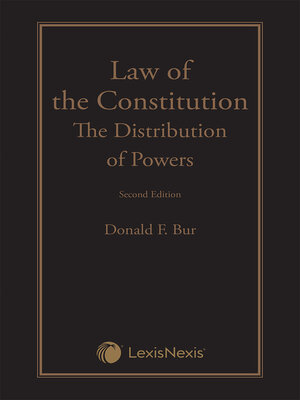
Sign up to save your library
With an OverDrive account, you can save your favorite libraries for at-a-glance information about availability. Find out more about OverDrive accounts.
Find this title in Libby, the library reading app by OverDrive.



Search for a digital library with this title
Title found at these libraries:
| Loading... |
The Constitution Act, 1867 provided this country with one of the oldest federalist constitutions in the world. Under that Constitution, legislative jurisdiction was distributed between the Canadian Parliament and the provincial legislatures through a unique system of described classes and matters that come within those classes.
Until now, the courts have developed and modified certain tests to determine the validity of legislation. As part of that process, the courts will find the matter by pithily describing the legislation at issue, and then assigning that description to one of the classes according to the developed tests. The limits of each class, then, are ultimately defined by the types of matters that have been placed within them by the courts.
There are a number of problems with this methodology. Classes are supposed to have pre-determined boundaries, and they were supposed to be exclusive. Matter was supposed to simply come within those pre-determined boundaries, but now they are placed there by the courts. And, rather than matter being simply the content of the classes, it has been replaced by pithily described legislation or legislative subjects. Instead of being exclusive, classes are now overlapping. While that overlapping of jurisdiction should be acknowledged as a failure of existing constitutional methodology, it has instead been treated as inevitable. Thus, a few versions of paramountcy have been created to deal with it — even though that concept was expressly rejected by the parties to the constitutional conferences.
There is, however, another way.
Before confederation, the province of Canada had created a de facto system of federalism, and that system formed the origins of sections 91 and 92. It is not surprising, then, that an examination of the legislation in that de facto federalism discloses, in most cases, both the limits and the content of the various distributed classes in sections 91 and 92.
It should be a simple matter to determine class limits and class content. This book does this, and then undertakes an exhaustive analysis of federalism cases decided from 1867 to 2023 to find out how the courts have interpreted sections 91 and 92. Using the origins of these two sections as a base for analyzing court decisions, it is possible to see where the courts have deviated from that original compact, and why they have done so.
Written by veteran lawyer and constitutional law expert Donald F. Bur, Law of the Constitution: The Distribution of Powers, 2nd Edition offers an insightful and thorough look at the distribution of powers in Canada between the federal and provincial governments, and provides an analysis of how the courts have treated and decided the issues that have arisen in this context.
Features of This Book
In the second edition of Law of the Constitution: The Distribution of Powers, Dr. Bur conducts a comprehensive examination of the case law related to every class within section 91 and 92 across more than 2,000 pages. His analysis of class descriptions allows readers to understand how the courts have interpreted federal and provincial legislative jurisdiction. Through the discussion of legislative matters, his analysis of the content of each class allows readers to access most of the constitutional cases that have been decided, from all levels of court, and place them within a particular class context. Moreover, by operating from the objective basis of pre-confederation federalism—the federalism that formed the origins of sections 91 and 92—it is possible to provide a critique of the approaches taken by the courts, and the decisions that they have made.
This approach...






